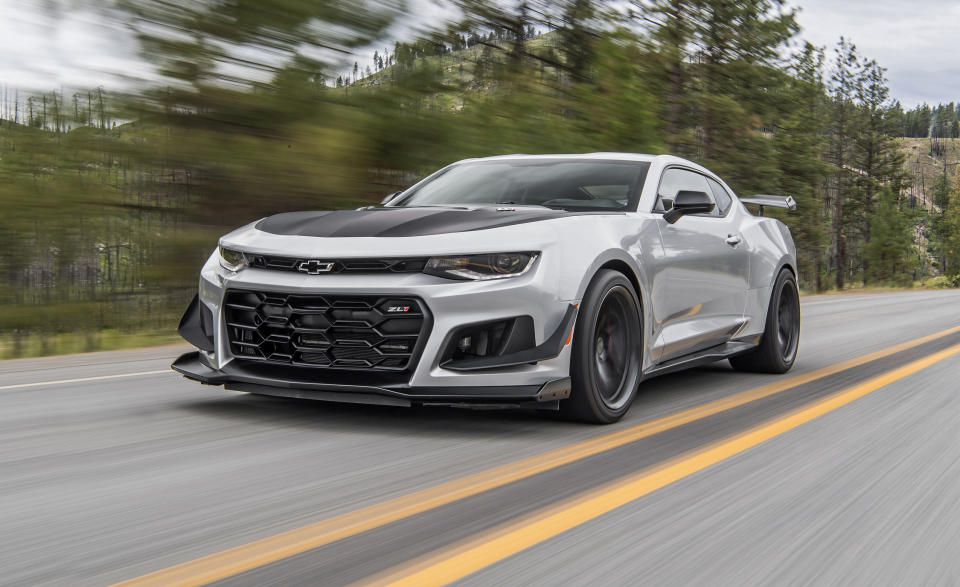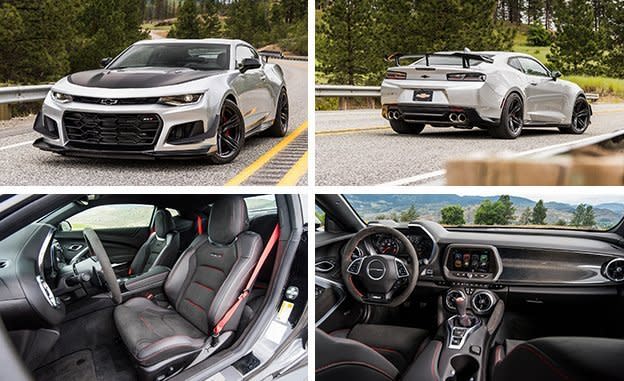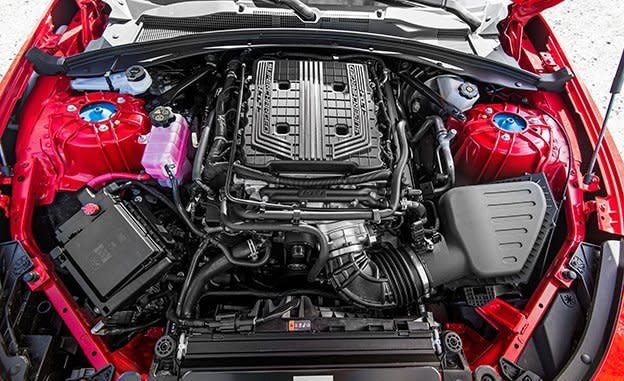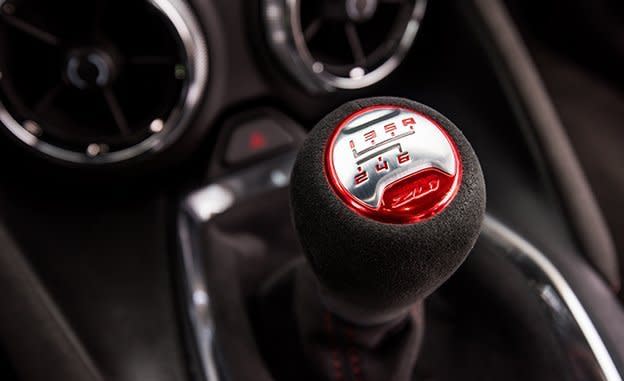2018 Chevrolet Camaro ZL1 1LE

Chevrolet must have one hell of an overtime budget for its performance-vehicles department. In just the past few years, there have been SSs, Stingrays, 1LEs, Z51s, Z06s, ZR1s, ZL1s, and even V-6 models that have consistently rewritten the bang-for-buck equation. (To say nothing of fellow General Motors brand Cadillac and its immensely talented V models.) Now comes this particular Camaro, one that combines two of those acronyms but wears an invoice price that doesn’t seem adequate to cover the sum of its parts.
The 2018 Camaro ZL1 1LE stretches the performance envelope like a cruise missile wearing a forty-nine-cent stamp. There’s the Corvette Z06–derived LT4 supercharged 6.2-liter V-8 good for 650 horsepower and 650 lb-ft of torque, the genuine carbon-fiber wing (a first for GM) designed in a Formula 1 wind tunnel that turns into the equivalent of 300 pounds of lead at 150 mph, the gaping front end that swallows three cubic meters of air per minute more than a regular ZL1, and the splitter and dive planes. Also, check out the rubber. GM tapped Goodyear and the tiremaker brought its Eagle F1 Supercar 3R to the table: 305/30ZR-19s in the front and 325/30ZR-19 steamrollers at the rear, which is the widest tire ever fitted to a Camaro. Goodyear says they are good for 1.10 g’s of lateral acceleration, but if our well-attuned necks are any gauge, we’re thinking it’s even higher than that. The rubber is wrapped around forged-aluminum wheels one inch smaller in diameter than the regular ZL1’s; along with the tires and compared with the non-1LE car, those rollers save 13 pounds in precious rotating inertia and unsprung mass.

Damper Dan
The other half of the chassis performance comes from Canadian supplier Multimatic in the form of aluminum-bodied spool-valve dampers. Not only do they provide an elegant and passive way to vary damping force, the inverted struts provide a means to achieve race-car-like negative camber at the front end. Via a trick method to switch back and forth between street and track settings, the ball-jointed and forged-aluminum top mount of the front strut is adjustable to increase negative camber by 1.7 degrees. To set the car to track camber, jack one corner, remove an alignment pin in the wheel well and the three bolts at the top of the strut tower under the matte-black hood, twist the top mount 180 degrees (it has a dual bolt pattern), reattach, and—voilà—instant camber. Combined with fairly common eccentric alignment bolts, the ZL1 1LE can have as much as 3.7 degrees of negative front camber, although Chevy recommends negative 2.7 on the track.
The four dampers together are about 23 pounds lighter than the 2014–2015 Z/28’s steel-bodied dampers. The rear subframe and its multilink suspension are insulated, if you want to call it that, by aluminum pucks, and the rear anti-roll bar is adjustable to three positions. Locking down the rear end and firming up the front communicates every crack in the road and even the slightest variation in lateral thrust with a sniper’s precision.
All of this variability was engineered into the car to allow owners to fine-tune their Camaros to their home tracks. At the Jacques Villeneuve–designed Area 27 in British Columbia, we ran 40-plus laps of the 3.0-mile circuit. It was the brakes—the iron-rotor units carry over from the regular ZL1 except for the ABS calibration—rather than spent tires that prevented us from turning more than five hot laps at a time; the pedal gets a little long on the fifth lap. While we’d like to have seen the 1LE adopt the carbon-ceramic brakes of the Z/28, they’d be costly, and few cars feel as stable while braking in corners as the 1LE. Even when you throw in a downshift, the car never unsettles. The tires claw for grip in corners like a cat scurrying up a tree. Where you expect understeer, you get a neutral balance, and squeezing extra throttle on exit causes the rear end to step out gently—or aggressively if you simply put the hammer down too quickly. We’re quite sure there isn’t a tire made that could contain the LT4’s 650 lb-ft of torque.

When one feels the desire, the car will accelerate in a straight line, too. GM claims the 1LE transformation saves 60 pounds, so we don’t expect the manual-only 1LE to be all that much quicker than the manual-transmission ZL1 coupe we tested. Call it 3.7 seconds to 60 mph and 11.9 in the quarter-mile. The ZL1 automatic will remain the quickest Camaro, despite being roughly 100 pounds heavier than this car.
All That and a Bag of Creature Comforts
While the chassis mods make it a fantastic track weapon, this car is somewhat compromised on the street. Not overly so, but you’ll want to avoid every pothole due to springs that are three times stiffer than those of the regular ZL1. Matt Scrase, the engineering manager for the Camaro 1LEs and ZL1s, admits that he wanted to make the car a bit more extreme by ditching some creature comforts—the trunk lining, for example. He was thwarted by GM historians who wanted to keep the 1LE true to its roots as an additive option, not a give-and-then-take one, a philosophy that dates to the third-generation Camaro. Unlike the last-generation Z/28, this 1LE has all the features of the ZL1, including heated and cooled seats, a heated steering wheel, a head-up display, and an 8.0-inch infotainment system. Options are limited, with Chevy’s Performance Data Recorder ($1300, it’s a forward-looking camera and data logger), a navigation system ($495), and carbon-fiber interior trim ($500) being the only factory extras.
One thing you won’t see in a ZL1 1LE is an automatic transmission. Its manual ’box is identical to the ZL1’s six-speed except for a shorter sixth gear (0.68:1 versus 0.54:1). The shifter is crisp and lacks any noticeable wiggle in the gates. Activating the automatic rev-matching downshifts turns heel-and-toe amateurs into professional throttle blippers, at least by appearances.

The shorter ratio in top gear equates to an engine turning 1000 rpm faster at racing pace. There are only a few tracks this side of Bonneville that need sixth, and one of those is the Nürburgring Nordschleife. At that hallowed German track, a ZL1 1LE turned a lap in seven minutes and 16 seconds, which is more than 21 seconds quicker than the last Z/28 and 13 quicker than the current ZL1.
That ’Ring time puts the ZL1 1LE in the company of near-vaporware from carmakers such as Gumpert, Radical, and Donkervoort. The best part of this package is its asking price: $71,295. Very nearly anything else operating in this performance stratum is easily two or three times costlier; the next closest performer is a Corvette Z06 with the Z07 package, and even that performance value costs about $20,000 more. Just don’t tell Chevy’s accounting department it could charge a lot more for this track animal, okay?
Specifications >
VEHICLE TYPE: front-engine, rear-wheel-drive, 4-passenger, 2-door coupe
ESTIMATED BASE PRICE: $71,295
ENGINE TYPE: supercharged and intercooled pushrod 16-valve V-8, aluminum block and heads, direct fuel injection
Displacement: 376 cu in, 6162 cc
Power: 650 hp @ 6400 rpm
Torque: 650 lb-ft @ 3600 rpm
TRANSMISSION: 6-speed manual
DIMENSIONS:
Wheelbase: 110.7 in
Length: 188.3 in
Width: 74.7 in Height: 52.0 in
Passenger volume: 85 cu ft
Trunk volume: 9 cu ft
Curb weight (C/D est): 3850 lb
PERFORMANCE (C/D EST):
Zero to 60 mph: 3.7 sec
Zero to 100 mph: 8.4 sec
Standing ¼-mile: 11.9 sec
Top speed: 190 mph
FUEL ECONOMY (C/D EST):
EPA combined/city/highway: 15/12/20 mpg

 Yahoo Finance
Yahoo Finance 